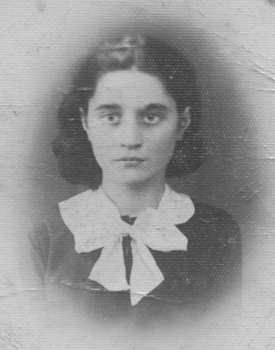Introduction
 Sala Garncarz, 12 years old, Sosnowiec, Poland, 1936
Sala Garncarz, 12 years old, Sosnowiec, Poland, 1936In 1991, as 67-year-old Sala Garncarz Kirschner
prepared herself for triple bypass surgery, she opened a
painful chapter of her past.
For nearly five decades she had shielded her three children
from her Holocaust years, never talking about her Polish
Jewish family’s
experiences during World War II.
One summer day that year, she approached her daughter, Ann, carrying
a red cardboard box that had once contained a “Spill and
Spell” game. She held it out, saying, “You should
have this.” Within the box was a small, worn brown leather
portfolio stuffed with letters, postcards, and scraps of paper—an
amazing array of Polish, German, and Yiddish writing, some of
it barely legible, tiny and cramped, some of it beautiful calligraphy.
The postcards were covered with stamp-size Hitlers and thick “Z” stamps. “These
are my letters from the war,” Sala told her daughter.
That afternoon, Sala began to fill in the missing pieces of her
history. She was taken from home when she was 16 and survived
five years in seven different Nazi forced labor camps. Saving
the letters became inextricably linked with saving her life. The
letters were not mere pieces of paper: they were the people she
loved, friends and family waiting for her return. She risked her
life to preserve the letters, hiding them during line-ups, handing
them off to friends, throwing them under a building, even burying
them, but always managing somehow to take them with her from camp
to camp.
Liberated in 1945, Sala came to the United States as a war bride,
and hid her papers in a closet. Five years of her life were also
hidden until the day she revealed the existence of more than 300
letters, photographs, and documents.
Sala’s story is, above all, a story of life and one young
woman’s way of seeing beyond years of horror. From her letters,
we learn about friendship and love, Jewish life in occupied Poland,
Nazi labor camps, the intensely human need to rebuild life after
the catastrophe of war, and the ability of words to give and sustain
life.
Jill Vexler, Ph.D.
Guest Curator
Ann Kirschner, Ph.D.
Consultant to Letters to Sala
Debórah Dwork, Ph.D., Robert
Jan van Pelt, Ph. D., Holocaust Historians
Consultants to Letters to Sala
Unless otherwise indicated, the
letters, photographs, and
documents in the exhibition are drawn from the Sala Garncarz Kischner Collection, donated by the Kirschner family in April 2005 to
the Library’s Dorot Jewish Division.
Support for this exhibition has been provided by the Righteous Persons Foundation, the Conference on Jewish Material Claims Against Germany, the French Children of the Holocaust Foundation, and HBO.
Support for The New York Public Library’s Exhibitions Program has been provided by the Celeste Bartos Charitable Fund and by Sue and Edgar Wachenheim III.
A Note on Personal Names:
In the correspondence, the spelling of personal names sometimes
varies, and diminutives and nicknames are often used. In the
exhibition we have adopted consistent forms for the names of
individuals who are mentioned frequently; these names will not
always match signatures, return addresses, or references within
the letters themselves